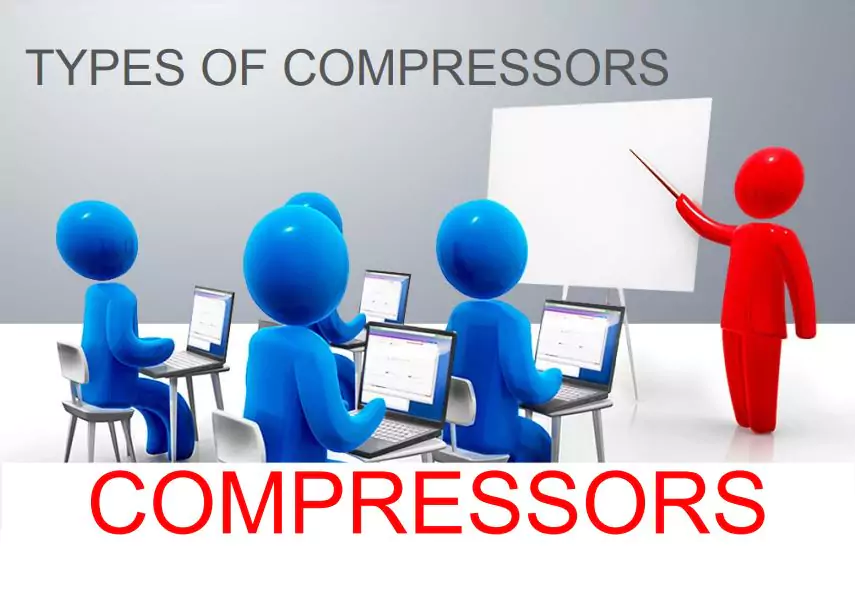‘Types Of Air Compressors Working Principle Application’ PDF Quick download link is given at the bottom of this article. You can see the PDF demo, size of the PDF, page numbers, and direct download Free PDF of ‘Basics Of Centrifugal Compressors’ using the download button.
Compressor And Its Types PDF Free Download

Compressor
INTRODUCTION
The process of increasing the pressure of a gas (usually air), by reducing its volume is called compression.
A compressor is a mechanical device that is used to compress gases.
A compressor compresses the low-pressure gas and delivers it at a higher pressure in the right quality.
Working Principle
The compressor is a work-absorbing device.
It increases the pressure of a gas by doing work on it.
This means it requires work input and a prime mover is required for its working.
The most common choice for a prime mover is the electric motor, but an IC engine or a turbine can also be used.
Air compressors
A compressor used for compressing air is called an air compressor.
Air from the atmosphere is sucked into the compressor.
The compressor then compresses air to high pressure and delivers it to a storage tank (reservoir).
From the reservoir, compressed air can be supplied to desired locations through pipelines.
Industrial Uses of Compressed Air
Air compressors are used for supplying high-pressure air. Compressed air accounts for about 10% of the global energy used in industry today. There are many uses of high-pressure air in the industry.
The main uses of compressed air are :
In compressed air engines (air motors) used in coal mines,
Fuel injectors; to inject or spray fuel into the cylinder of a Diesel engine.
Operating pneumatic machines and equipment such as drills, hammers, etc.
Air brakes for locomotives and railway carnages, buses, and trucks.
Water pumps and sprays paint machines,
For starting aircraft engines and large (heavy) Diesel engines,
For industrial cleaning; such as cleaning workshop machines, generators, automobiles, etc.
To operate blast furnaces and gas turbine plants.
Supercharging in I.C. engines.
Applications of Compressors
- We may not realize the importance of compressors in our daily lives.
- However, the range of applications of compressors is very wide.
- From small units such as refrigerator compressors to huge industrial units.
- Reciprocating compressors are most commonly used, ranging in size from 0.1 hp to 25 hp.
- Rotary compressors are available in small sizes (in cars) to 500 hp.
- Centrifugal compressors are often used in sizes ranging up to 10,000 hp.
- The type and size of the compressor depend upon its application and cost.
Classification Of Compressors
Depending upon on the principle of compression employed, compressors are classified into two major categories:
Positive displacement compressors
Dynamic displacement compressors
Positive Displacement Compressors
In these types of air compressors, compression is achieved by positive displacement of a solid boundary, which compresses the gas in a closed compression chamber.
The compressor may have single or multiple intakes and compression chambers.
These compressors are capable of producing very large pressure ratios.
Working
Atmospheric air is drawn into the compression chamber(s) through intake valves,
The valves are then closed and the volume of each chamber is gradually decreased mechanically.
As a result, air gets compressed in the chambers.
When the designed pressure is reached, the delivery valve(s) is opened and the compressed air is discharged into the reservoirs.
Types
Based on the compression mechanism used, Positive displacement compressors are divided into two main groups:
Reciprocating compressors
Rotary compressors
Dynamic Displacement Compressors
Also called steady-flow or turbo-compressors.
The dynamic compressors have a rotating impeller.
Here compression of gas does not occur in a closed volume.
The flow of gas is continuous in these compressors.
The dynamic action of the impeller on the gas increases its pressure.
They are widely used in chemical and petroleum refineries
Types
Steady flow compressors are of two types:
- Centrifugal Compressor
- Axial Compressor
Advantages
- Can handle large quantities of air or gas at lower pressures.
- Being high-speed machines, they are smaller in size,
- Provide uniform delivery of gas without requiring a large receiver,
- Deliver more clean air, as there are fewer sliding parts requiring lubrication,
- Present no balancing problems,
- Lower maintenance expenses,
- Require less operating attention.
| Author | – |
| Language | English |
| No. of Pages | 30 |
| PDF Size | 7 MB |
| Category | Education |
| Source/Credits | uomustansiriyah.edu.iq |
Compressor And Its Types PDF Free Download
